59+ Sample Audit Checklist Templates
-

Compliance Audit Checklist Template
download now -

HR Audit Checklist Template
download now -

Audit Checklist Template
download now -

Safety Audit Checklist Template
download now -

Compensation and Benefits Audit Checklist Template
download now -

Management Audit Checklist Template
download now -

Restaurant Audit Checklist Template
download now -

School Safety Audit Checklist Template
download now -

Free Environmental Compliance Audit Checklist Template
download now -
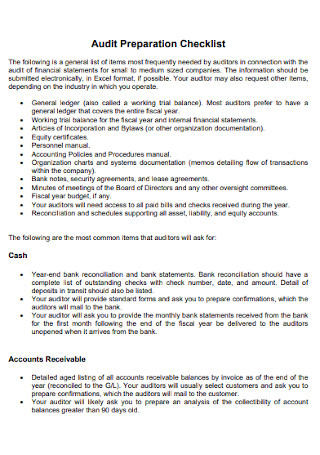
Audit Preparation Checklist
download now -

Sample Audit Checklist Template
download now -

Compliance Audit Checklist
download now -

Checklists for Computer Audit
download now -

Power Audit Checklist Template
download now -
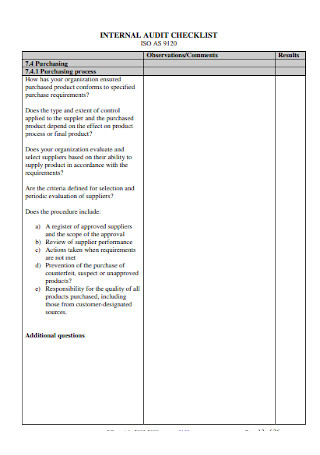
Sample Internal Audit Checklist
download now -

Legal Audit Checklist Template
download now -

Software Self-Audit Checklist
download now -
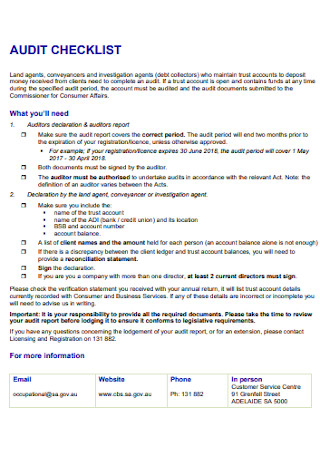
Business Audit Checklist Template
download now -
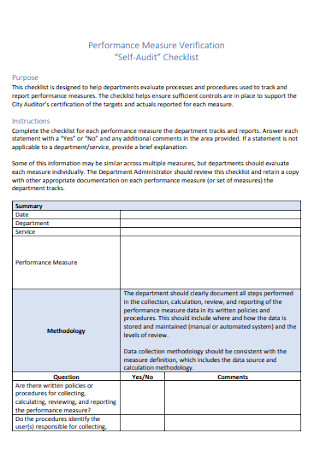
Audit Verification Checklist Template
download now -

Audit Service Checklist
download now -

Risk Management Audit Checklist
download now -

Self Audit Checklist Template
download now -

Club Licence Audit Checklist
download now -

Corporate Audit Report Checklist and Form
download now -

Financial Audit Checklist
download now -

Self Audit Management Checklist
download now -

System Audit Checklist Template
download now -

Pharmacovigilance Audit Checklist
download now -

Association Audit Checklist
download now -

Email Audit Checklist
download now -

Company Audit Checklist Template
download now -
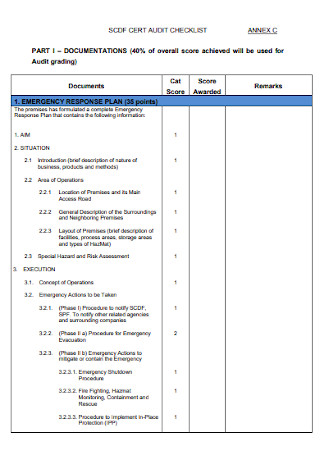
Basic Audit Checklist Template
download now -

Supplier Audit Checklist
download now -

Computing Audit Checklist
download now -

Security Audit Checklist
download now -

Simple Audit Checklist Templates
download now -

Facilities Security Audit Checklist
download now -

Accessibility Audit Checklist
download now -

Compliance Audit Checklist Example
download now -

Shopping Audit Checklist
download now -

Telehealth Audit Checklist
download now -

Protection Program Audit Checklist
download now -

Operator Accreditation Audit Checklist
download now -

Construction Audit Checklist
download now -

Basic Human Resource Audit Checklist
download now -

HR Function Audit Checklist
download now -

Office Audit Checklist
download now -
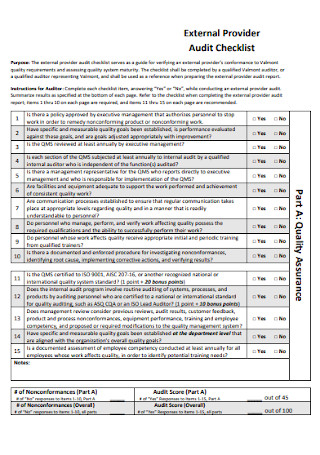
External Provider Audit Checklist
download now -

Accreditation Audit Checklist
download now -

Brand Audit Checklist
download now -

Policy Audit Checklist
download now -
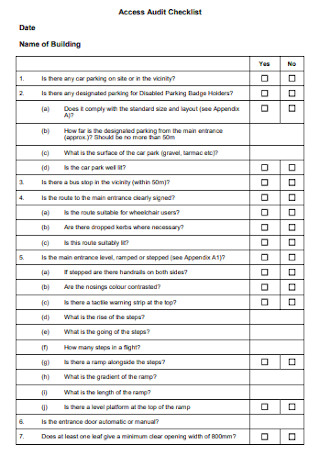
Access Audit Checklist
download now -
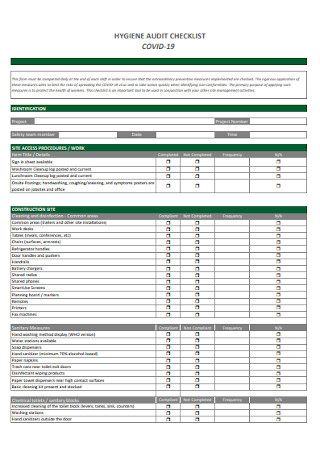
Hygiene Audit Checklist
download now -

Business Manager Audit Checklist
download now -

Manufacturing Organization Audit Checklist
download now -

Survey Audit Checklist
download now -

Company Audit Training Checklist Template
download now -

Electrical Audit Checklist
download now -

School Audit Checklist
download now -

Website Audit Checklist
download now
What Is an Audit Checklist?
Audit refers to two meanings. According to Investopedia, it scrutinizes primarily on financial statements and records. On another note, audit means to examine more than just finances. Internal audit, for example, aims to improve an organization’s operations. So, an audit checklist is a tool used for inspecting and evaluating business processes, management, and services. And this checklist involves criteria to conduct maintenance.
According to the Business Journals, more than 32.5 million businesses in the US existed in 2016.
Also, did you know that there were around 1.4 million accountants and auditors in the US back in 2018?
On the other hand, ISO Update stated that in standard, audits are necessary monthly, quarterly, yearly, or biyearly.
Why Is an Audit Checklist Important?
Audit checklists are essential in monitoring businesses and organizations. Without auditing, there might be hidden problems at work that could never be figured out. Hence, continuous issues lead to endless failures. And that would not bring a positive reputation to any company or group. Thankfully, audit checklists are useful instruments in making an evaluation report. And practical solutions will be strategized when evaluations give poor results.
What else is so special about an audit checklist? The whole list is structured and formatted meticulously. And the list’s content is made according to a set of standardized criteria or requirements. Thus, everything is laid out on what to inspect or assess at work. Your only goal is to follow the instructions and tasks outlined in the sheet, making it an easy auditing process.
Audits: Then vs. Now
Are you aware that the auditing process can be traced back to the 15th Century? That’s right. A long time ago, the royals and merchants figured out a way to lessen theft, fraud, or abuse of authority. People used different methods, such as questioning, independent verification, and job separation, to detect problems. But when you compare it today, internal audits are more than just avoiding theft, abuse of power, and the like. The process delves further by enhancing any organization’s performance as a whole. More so, evaluating performances is not a one-time process only. According to ISO Update, standard audits occur monthly, quarterly, yearly, or biyearly.
What Are the Examples of Audit Checklists?
Every organization differs in terms of what an audit checklist contains. People don’t always have similar objectives, systems, and operations in the first place. But aside from being different, there are also common denominators to find from various examples. And in this segment, we will outline some of the common examples of how the audit checklists are used.
What Are the Main Audit Sections?
Audit checklists often come in three main segments. And they each serve for a particular focus—management plan, finance, and operations. So make sure your list includes these three categories to observe a successful assessment. What does each factor mean, you might ask? Take a closer look at the meaning of each audit section:
Management
In your checklist, the management category refers to how your organization is managed as a whole. Expect to investigate down from the business plans, employee management, sales plans, job descriptions, to the disciplinary terms. This type also focuses on the management’s practices and beliefs, including the quality of products and services.
Finance
Form the word itself, all topics related to financial applications and functions are under the finance section. Financial plans, investments, business transactions, and specific funds are examined here. What if there are inaccurate records on the price and amount of particular products? Those will affect business operations big time. Also, this segment manages credit policies, tax withholdings, and tax returns.
Operations
The critical points to investigate include business operations. Topics like the production flow, quality, marketing, and promotions fall under this category. It will also be crucial to address competition, inventory control, training services, and supplier relationships. And if factors are slowing down operations, then solutions should follow.
How to Create an Audit Checklist
In America, there were approximately 32.5 million businesses in 2016. And each company has its approach on how to manage the audit. Otherwise, every enterprise might fall one by one without checking the total performance of an organization regularly. And since you already know the audit’s definition, examples, and sections, you are now ready to create the audit checklist itself. Here are the steps on how to make an audit checklist:
Step 1: Identify the Area or Department to Audit
First things first, what subject is under audit? Is it a restaurant, healthcare, or customer service audit? Merely putting the “Audit Checklist” title makes the sheet too broad anyway. Be sure to specify the subject. And if you are having strategic planning to create a hospital audit checklist, don’t forget to state the hospital’s name and other specifics.
Step 2: Insert the Criteria to Examine
Audit checklists are useful for monitoring and evaluating due to its structured rubrics. For example, you set a retail audit. The criteria may check if the retail store is accessible for public transport and people with disabilities. Or perhaps, you evaluate if the store is sanitary enough. Also, does the store do well in terms of sales volume and stock levels? Such examples are just a few of what to incorporate in your criteria. Be sure to focus the rubrics on what’s relevant and crucial to your subject.
Step 3: Separate the Audit into Three Sections
Can you still recall the main audit sections discussed before? Those are your three main categories for the audit checklist. Put all the parameters related to management under the management section. And the same goes for finance and operations. Categorizing into segments will make a list more organized instead of just enumerating every task to do.
Step 4: Tweak the Checklist’s Format
Speaking of organized, observe a decent format to your checklist. That way, you don’t have to write long paragraphs into the sheet. Simply write in straightforward phrases about each listed parameter. Aside from words, add tables, bar graphs, lines, and visual organizers in presenting your list too. And with our editable sample templates, your preferences will happen.
Step 5: Take It Easy
If there are many enlisted tasks or criteria written under the audit checklist, then don’t make the content more difficult. Simple words and language would suffice as long as everything written in the list is understandable. Don’t forget to put instructions if you plan to make the sheet for someone else assigned for the audit. And if you are unsure if the document is already exceptional, then put yourself in an auditor’s shoes. If things still seem confusing, then make some changes until you perfect everything.
FAQs
Who prepares the audit checklist?
Audit checklists are prepared by auditors or anyone assigned to handle the auditing process. In fact, there were about 1.4 American million auditors and accountants in 2018. That is, according to the US Bureau of Labor Statistics. And their job is crucial to organizations to keep the business going. Also, other people may create an audit list for auditors to follow.
What are the types of audits?
According to Investopedia, there are three types of audits. They are the external, internal, and internal revenue service (IRS) audits. And all types shape an effective audit for any business or organization.
What is an audit technique?
Audit techniques refer to the procedures, tools, or methods that auditors use to gather results and evidence in auditing.
American engineer William Edwards Deming once said, “Quality is everyone’s responsibility.” That quote applies to businesses where delivering top-notch quality performance is a must. So, auditors are not the only ones assigned to maintain impressive quality and performance at work. Encourage everyone to be involved in auditing instead. And with the use of an audit checklist, everyone can slowly develop the quality of business operations, finance, and management.
